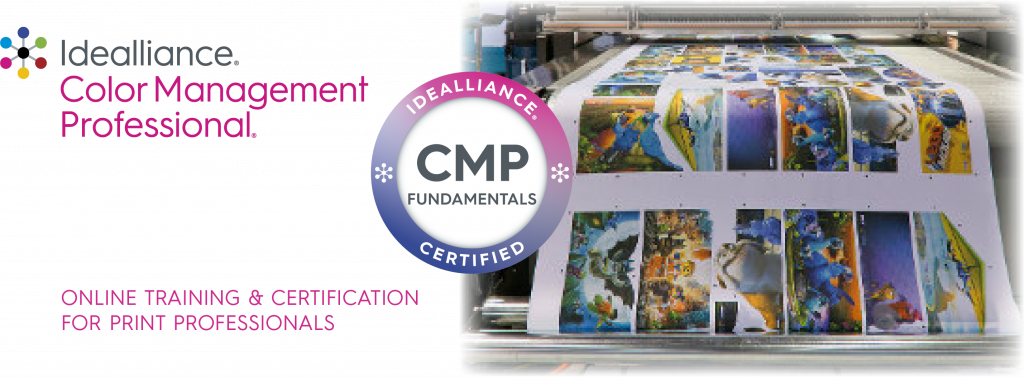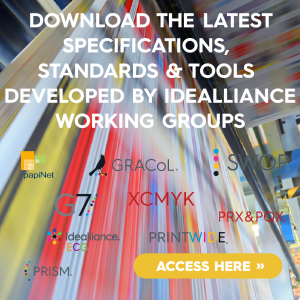GRACoL®

FREE GRACoL® DOWNLOADS
Developed by Idealliance with its members, GRACoL® is a set of industry guidelines and recommendations to help print buyers, designers, and specifiers work more effectively with their print suppliers. The GRACoL committee, along with SWOP® committees are now a part of Idealliance’s Print Properties Committee (PPC), which develops leading standards across graphic communications, print, packaging and aligned industries. Join Idealliance & PRINTING United Alliance to participate in the PPC & shape printing together.
Solutions developed by Idealliance, a division of PRINTING United Alliance, for leading graphic communications, print & color management production include test charts, profiles, and other tools used across the industry, around the world, and adopted as international specifications.

PROFILES & DATASETS
The Expanded Gamut (ECG) 7 color datset and profile defines a reference print condition for 7 color (CMYK+OGV) expanded color gamut (ECG) printing. The profile dataset and profile is based on high-quality sheet-fed offset printing using standard IS0 12647-2 compliant CMYK inks and Orange, Green, and Violet designed to provide a standard 7 color print condition which can be used in design, proofing, and print on litho and flexo printing systems.
Color Settings Files (CSF), for Use with Adobe CC/CS Applications. Included in this download are CSF files for GRACoL 2013, SWOP 2103, as well as a complete family of 7 G7 based datasets for different substrates and printing processes (ISO 15339/CGATS 21)
This is the profile for GRACoL 2013 (CRPC6) customized for clay coated news back (CCNB), co-developed by Idealliance through the global Print Properties & Colorimetric council.
The SWOP and GRACoL 2006 Characterization Data Sets. These are used for creating a SWOP3, SWOP5, or GRACoL1 proof.
These are the ICC profiles for both SWOP 2006 and GRACoL 2006 Specifications.
This download includes ISO/PAS 15339-2/CGATS 21 CRPC Profiles 1-7, including GRACoL 2013, and SWOP 2013, as part of the 7 common, G7 based, Characterized Reference Print Conditions. (Current ICC Version 4.)
Datasets can be found here (below ISO/PAS 15539 Reference Print Conditions).
ISO/PAS 15339 Graphic technology – Printing from digital data across multiple technologies. The following data files are a normative part of ISO/PAS 15339-2. Includes: ISO15339-CRPC1 – Typical Coldset News – Small gamut printing (newsprint). ISO15339-CRPC2 – Typical HeatsetNews – Moderate gamut printing on improved newsprint type paper. ISO15339-CRPC3 – Typical Prem Uncoated – Utility printing on a matte uncoated type paper. ISO15339-CRPC4 – Typical SuperCal – General printing on super-calendared paper. ISO15339-CRPC5 – Typical PubCoated – Typical publication printing. ISO15339-CRPC6 – Typical PremCoated – Large gamut (typically commercial) printing. ISO15339-CRPC7 – Typical Extra Large – Extra-large gamut printing processes.
This download includes ISO/PAS 15339-2/CGATS 21 CRPC Profiles 1-7, including GRACoL 2013, and SWOP 2013, as part of the 7 common, G7 based, Characterized Reference Print Conditions. These profiles were built to the ICC Version 2 specifications for use with legacy software that is not compatible with current ICC Version 4 profile specifications. See the above ICC profile listings for the current ICC Version 4 profiles.
PrintWide is a new, extremely large-gamut CMYK dataset designed to encompass the gamut of virtually all inks or colorants in all known color printing systems and serves as a CMYK translation space and G7 aligned saturation booster. Although the dataset has only four channels (CMYK), its gamut includes the effect of typical “extended-gamut” inks such as OGV (Orange, Green and Violet) or RGB (Red Green and Blue) often used in ink-jet, flexo or offset printing.
The Uncoated UV dataset and profile defines a reference print condition for printing on uncoated paper using ultra-violet (UV) curable inks. The profile dataset and profile is based on high-quality sheet-fed offset printing using standard ISO12647-2 compliant CMYK UV inks, designed to provide a standard print condition which can be used across similar print environments, much like the reference print conditions defined by GRACoL, SWOP and other G7 based profiles which serve as the common global CRPCs defined in ISO 15339.
XCMYK is a new color space representing expanded gamut printing that can be achieved on offset and digital devices. The XCMYK dataset and profiles can reproduce a larger gamut than that of GRACoL®, the industry’s current standard for print quality. Profiles can be used on traditional four-color presses as well as on a variety of digital devices to produce a color space larger than current traditional printing. Review an XCMYK Gamut Analysis by Multi Packaging Solutions.
The Idealliance ISO 12647-7: 2013 3 row control wedge, including XCMYK color space reference data.

TEST CHARTS & CONTROL WEDGES
Idealliance, known for creating legendary print standards and specifications such as GRACoL®, SWOP®, and G7® has released an Expanded Color Gamut (ECG) characterization chart for use in characterizing and calibrating multicolor print processes. The Expanded Color Gamut (ECG) Characterization Chart was created by a subcommittee within the Idealliance Print Properties and Colorimetric Council as a part of the Idealliance Global ECG project. The Idealliance Global ECG is designed to make 7 color process printing as predictable and normal as current CMYK printing specifications such as GRACoL and SWOP. The characterization chart will complement a comprehensive Expanded Color Gamut (ECG) Project Kit which contains guidelines, proofing control strips, and other tools for print users.
The Idealliance ISO 12647-7 Control Wedge 2013 has 3 rows and 84 patches vs. the 2-row 54 patches in the original 2006 version. The wedge is intended primarily as a control device for prepress proofs but may also be used to control production printers or presses. The target must pass through exactly the same imaging process as a live image, including RIP curves, color management, screening, etc. The target MUST be included on all proofs submitted for Idealliance Proofing System certification. Values measured from the target will be used as part of the Idealliance proofing system certification process. The target SHOULD be included on all production proofs and measured to confirm the accuracy of every proof. | The Large Aperture Device version can be downloaded here. | The previous version, Idealliance ISO 12647-7: 2009 Digital Control strip, can be downloaded here.
The IT8.7/5 (TC1617x) is a new CMYK printer characterization target combining the unique patch values in the standard IT8.7/4 target with all the patch values in columns 4 and 5 of the P2P51 target. The TC1617x maintains the same patch count as the IT8.7/4 (1,617 – hence the name) by removing 29 duplicate patches from the IT8.7/4 and replacing them with the 29 patches in columns 4 and 5 of the P2P51 that were absent in the IT8.7/4. | The Large Aperture Device version can be downloaded here.
These are the IT8.7/5 / TC1617x datasets for Characterized Reference Printing Conditions 1-7 as part of ISO 15339.
The first of its kind for this segment of the industry, the Idealliance Large Format – Industrial – Textile Printing Control Wedge was created by the Idealliance Print Properties & Colorimetric Council in order to support the wide format, industrial and textile print segments of the industry. The control wedge is designed to help digital print users on non-traditional substrates exceptionally control their print processes. The control wedge comes in a variety of configurations and can be read with devices that have larger apertures and work especially well in situations with uneven surfaces, textiles, and wide format printing.

COLOR TOOLS
The Idealliance Print Properties and Colorimetric Council have created a kit detailing steps which can improve the proof to press match by using SCCA (Substate Corrected Colorimetric Aims) adjusted versions of CRPC (Characterized Reference Print Conditions) profiles, and/or by creating custom versions of CRPC and substrate profiles using custom daylight color temperatures. The kit contains extensive documentation on how to improve the press to proof match. In addition, the Idealliance Print Properties Council has created SCCA adjusted versions of GRACoL® 2013 with higher levels of OBAs.
The Idealliance Print Properties and Colorimetric Council have created a kit detailing steps which can improve the proof to press match by using SCCA (Substate Corrected Colorimetric Aims) adjusted versions of CRPC (Characterized Reference Print Conditions) profiles, and/or by creating custom versions of CRPC and substrate profiles using custom daylight color temperatures. The kit contains extensive documentation on how to improve the press to proof match. In addition, the Idealliance Print Properties Council has created SCCA adjusted versions of GRACoL® 2013 with higher levels of OBAs.
The Observer Metamerism in Soft Proofing White Paper is a result of extensive research to find the causes behind metamerism when viewing color not only on different monitors but addresses observer metamerism, which is when two people see color differently on a single monitor. This research not only creates awareness, but provides options on what to look for, and recognize possible solutions.
Idealliance 2013 Proof Verifier for use with GRACoL 2013, SWOP 2013 and as well as a complete family of 7 G7 based datasets for different substrates and printing processes (ISO 15339/CGATS 21). This download contains a spreadsheet that allows for manual verification of Idealliance print conditions.
*Updated 2019* The Substrate Relativity Calculator allows advanced users the ability to recalculate industry-standard or custom characterization data sets based on the CIELAB values of a given substrate. The procedure utilizes the tristimulus correction methodology defined in ISO 13655 Annex A for correcting measurements based on two backing materials. Once the data is modified relative to the new CIELAB values, the user is provided an idea of how the substrate’s color will affect the final printed result. The recalculated data can be used to generate profiles for more accurate proofing/converting, and the reported CMYK, RGB, and Gray patches can be used for new process control aims when on press with the new substrate. A video introduction & walk-thru is also available to accompany the SCCA calculator, click here.






